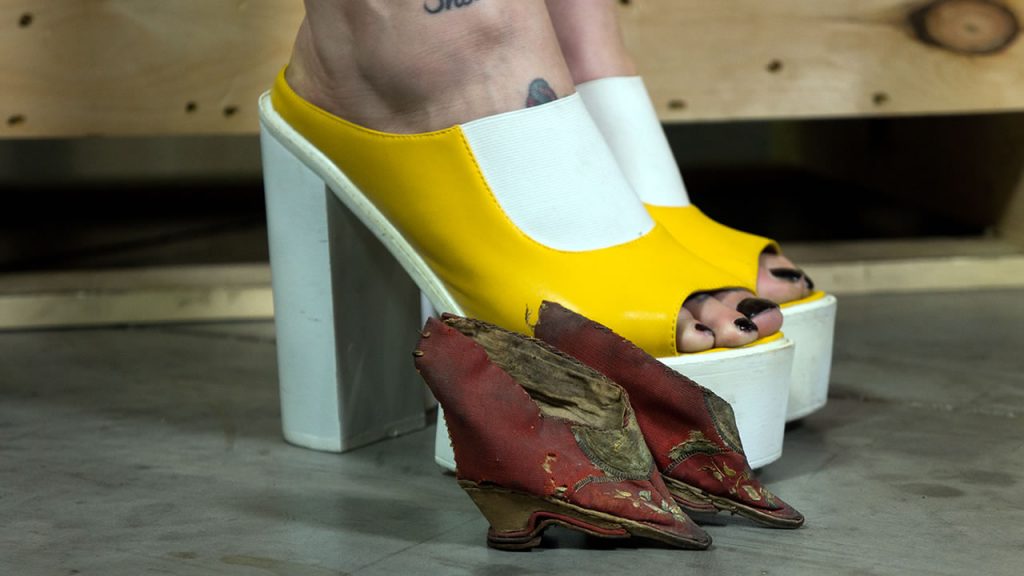Winner of the Fall 2016 StMU History Media Award for
Best Use of Scholarship
Best Article in the Category of “World History”
Best Use of Primary Sources
When I knew I couldn’t suffer another moment of pain and tears fell on my bloody bindings, my mother spoke softly into my ear, encouraging me to go one more hour, one more day, one more week, reminding me of the rewards I would have if I carried on a little longer. In this way, she taught me how to endure—not just the physical trials of footbinding or childbearing, but the more torturous pain of the heart, mind, and soul.1
More often than necessary, women are consumed with the idea of infatuation. Every culture has its own form of standards that pertain to women and what constitutes beauty. Although the world is slightly more accepting now, women used to go to extreme lengths to achieve an image that would be deemed attractive. In the Chinese culture, foot binding was that well-known beauty expectation for centuries. What started off as a celebrity fad, turned into a way of determining social status and eventually an all-around beauty expectation. 2 The objective of foot binding was for women to have the smallest foot possible, starting at very young ages. Not only was this a painful process for girls as young as five years, but it also promoted the idea that women must mutilate their bodies to become appealing to men. At some point in time, women began to just accept that this was something that was supposed to be done in order to be attractive. Often referred to as “lotus boats” or “golden lotuses,” bound feet started as a fad for the famous, and slowly made its way to becoming the social norm.3

This practice began around the tenth century with women in the entertainment business. These women were adored for their tiny arched feet and were seen by men to be much more attractive than middle class women with average feet. As these dancers were gaining an audience, the idea of “lotus feet” was becoming familiar. Not long after these performers expressed their “beauty,” foot binding became a norm for women who wanted to fit in and even for those who had a desire to find a husband.4 This painful process consisted of the breaking of young girl’s toes to form the desired triangular shape. Then the arch of the foot would be bent horizontally from the toes all the way to the heel. As if this was not painful enough, the girls were forced to walk on their feet to intensify the arch, breaking the foot even more. After all of this, the foot would be wrapped to maintain the shape of it as well as prevent any sort of deviation.5

Although this practice was around for centuries, it was only a matter of time before someone realized how inhumane and cruel it really was. Thankfully, many people began to protest against foot binding, forming “anti-foot binding organizations” to raise awareness on the inhumanity of binding women’s feet. By the 1950’s, laws were passed, allowing women to unbind their feet. Although hesitant at first, the trend slowly declined. Many women protested to unbinding their feet, due to the fact that it had been a social norm a thousand years. However, the movement against foot binding continued and eventually the last of the factories that make the tiny shoes were shut down, disabling the women from continuing the custom. Today, foot binding is no longer practiced and the only women who continue to maintain the tiny feet are those elder women who refuse to let go of the past.6
- Lisa See, Snow Flower and the Secret Fan (New York: Random House Publishers, 2005), 3-4. ↵
- Yaodong Gu et al., “Foot Loading Characteristics of Chinese Bound Feet Women: A Comparative Analysis,” PLoS ONE 10, no. 4 (April 2015): 1–9, doi:10.1371/journal.pone.0121695. ↵
- Yu-ning Li, Chinese Women Through Chinese Eyes (New York: Routledge, 2015), 125-127. ↵
- Women in the Middle Ages: An Encyclopedia, 2004, s.v. “Footbinding (Late 10th Century-early 20th Century),” by Patricia Buckley Ebrey. ↵
- Amanda Foreman, “Why Footbinding Persisted in China for a Millennium,” Smithsonian, accessed November 8, 2016, http://www.smithsonianmag.com/history/why-footbinding-persisted-china-millennium-180953971/. ↵
- “Women with Bound Feet in China,” Reshaping the Body: Clothing & Cultural Practice, accessed November 8, 2016, http://exhibits.hsl.virginia.edu/clothes/lady_bound/. ↵



189 comments
Nataly Solis Chavez
Wow! This was short but fascinating! In fact I was so captivated by the mere thought of women mutilating their own bodies to accommodate mens expectations that I took it upon myself to take a further look into the practice of foot binding and figure out why no one put an end to it sooner. The horrific images that arose were breath taking. Great article!
Briana Bustamante
This article is crazy! I still can not begin to imagine how Chinese women lived in the early 1900’s with binding their feet at an early age. I have always heard that beauty is different around the world, and i can see why. Foot binding is inhumane, and to have it be done to little girls as young as 5 years old is astonishing. Thankfully people were able to notice this and make changes. I loved the quote you used to catch our attention and the layout of your article.
Mariana Govea
Wow! Crazy to know how far this culture took beauty! Really good article! Very well articulated and organized! The content was clear and easy to understand! I had always heard of foot binding all the way since middle school but I never knew when they had started to prohibit it or about how long it would take for them to finish the process! Ouch I could not imagine all the pain all those women went through to just try to achieve the cultures idea of “beautiful”! But I feel like one can understand and see the whole picture better of why they would do it, since back then marrying and conceiving children was what every women wanted to do therefore if one women started to do this and men loved it , every women had to start doing it since they did not want to be left behind without a spouse! Interesting read!
Bailey Rider
This article is mind blowing. Today women have beauty expectations but nothing that could compare to this. I can’t even imagine a child having to break her feet to fit beauty standards so that she would be able to find a husband. I liked the way you organized the article and it was interesting to learn about the origins of the trend for “lotus” feet. It was also interesting to learn how when just legislation banning foot binding wouldn’t stop women from the practice that the government thought to close the tiny shoe factories. Great article!
Christian Lozano
It is horrible what the women of China back then thought they had to do to be seen as beautiful. But, like with any culture, there are always certain beauty standards that prevail. You could liken the pain to the endless hours of pain Men and Women go through in the gym to have an aesthetic body appealing to their fellow human beings.
Jacob Hall
all I can really say is wow. Honestly I feel like women need to be given more recognition for all the things they have done to make themselves look beautiful to men. every time I hear stories like these I just can’t believe that things like this actually happened. when I think about it I can’t figure out what is more disturbing, the fact that people let this happen, or that they didn’t stop it as soon as it happened. That being said i truly enjoyed this article and how it gave such a good description of what women did to achieve “beauty” or what was said to be true beauty.
Nicolas McKay
This was a very interesting article on one of the craziest social taboos I have ever heard off. While each culture has their own social taboos, the idea that people would mutilate their own bodies to this extreme is still unbelievable to me. Excellent job with your imagery as well. I had heard of these foot bindings, but I had never seen an image of what their feet actually look like after the process.
Salvador Rodriguez Gomez
The story behind foot binding is truly amazing in a bad way. I just don’t understand how something like that would be deemed as attractive and be socially acceptable let alone become a social norm. Thankfully the practice is no loner socially acceptable. Fantastic article!
Maalik Stansbury
So much crap they had to go through and pain as well .I couldn’t do it, even though it was their type of culture and society, but man that was painful. I loved how your style of the article. Fantastic job with the description and explaining what truly happened in a sense that it capture not just my eyes but other people who had read it.
Mia Diaz
This was a great article with a very interesting topic! I know it has become custom in today’s society for women to alter their experiences in order to become appealing my social standards, but I can never imagine physically harming myself, little sister, or anyone I care about just to conform to certain social standards. I am glad people finally came to their senses and disbanded the practice. Despite my outlook, there still may be people out there who find this practice reasonable and worth the pain. That is one of the great thing about diverse cultures, having people express different practices; even though I personally would have placed this act under the insane category.